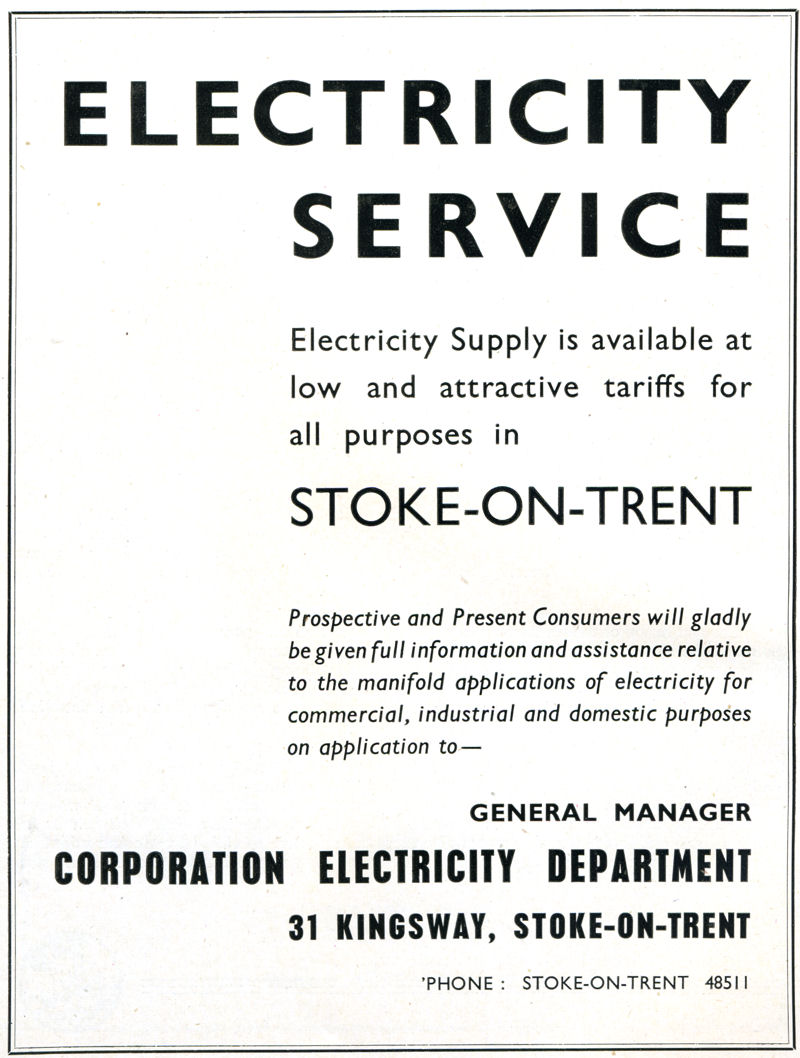![]()
|
|
|
|
|
Stoke-on-Trent - Advert of the week |
Potworks of the Week
Stoke-on-Trent Corporation Electricity Service - 1947

Stoke-on-Trent Corporation Electricity Service
from the 1947 - City of Stoke-on-Trent Handbook
|
ELECTRICITY SUPPLY IN STOKE-ON-TRENT "A public supply of electricity was commenced in the Potteries by the starting of the Hanley Electricity Works in the summer of 1894. In the beginning of the present century, a supply was commenced in Longton in September, 1901, the supply being on the low tension three-wire direct current system. Three or four years later supplies were .commenced in Stoke-upon-Trent and Burslem, the systems being the same as Longton, although working at a different voltage. The six Potteries towns (including Fenton and Tunstall in addition to those already mentioned) were federated in 1910 and became the County Borough of Stoke-on-Trent. The county borough became a city in 1925. The electricity supply came under common management on 1st September, 1910, and it was thus possible for the first time to consider the district as a whole. The area of supply comprises the City of Stoke-on-Trent and the Parish of Wolstanton in the former Wolstanton United Urban District which is now part of the Borough of Newcastle-under-Lyme. The supply area is about 36J square miles. Bulk supply is afforded to Newcastle-under-Lyme. Supply was first given under Provisional Orders granted for each area and these were consolidated by the Stoke-on-Trent Corporation Act, 1923. Change-over from the single phase 100 cycles supply in the centre of Hanley and from direct current in the areas so supplied, to the more efficient three-phase alternating current system has been completed so that there is now a uniform system of supply throughout the area, viz. alternating current, 50 cycles. To do this more than 190 three-phase transformer sub-stations have been put down over the whole of the area and from them low tension mains have been laid to afford local supplies. At 31st March, 1947, there were 479 miles of underground mains and 43 miles of overhead lines. On the same date there were 47 miles of streets and roads lighted by electricity, including 7 miles of main roads lighted by high pressure gaseous discharge lamps. The whole of the supply for the area is purchased from the North-West Midlands Joint Electricity Authority and sold by the Stoke-on-Trent Corporation. Sales exceed 200 million units per annum.
Prices and Charges. The tariff for electricity for lighting purposes is a flat rate of 4d. per unit subject to a quantity discount, while for commercial and industrial premises a long-hour lighting tariff, based on maximum demand, is available. The tariff for power supplies is from 1d. per unit. The large power consumers have the option of a tariff of £4 per k.v.a. per annum demand charge, plus ½d. per unit consumed. A quantity discount is allowed on quarterly accounts for power taken under these tariffs. Consumers taking large quantities on the three-phase system at extra high pressure can have special rates based on quantity taken, maximum demand, etc., subject to an agreement being entered into for a period of years. Domestic heating and cooking is 1d. per unit flat rate (quarterly meter) and 1¼d. (prepayment meter).The Multipart tariff, however, provides the most advantageous terms to the domestic consumer. It comprises a fixed charge based on the floor area of the premises and a consumption charge of one halfpenny a unit. There are, in addition, various alternative tariffs for domestic supplies and for business premises. Full particulars of the tariffs will gladly be given on application to the Department. Industrial Supplies. Reference should be made to the increasing use of electricity in industry, particularly in the staple industry of the district, where use of electricity for pottery firing, as well as for motive power and other industrial purposes, is increasing very rapidly. Bulk supplies for industrial purposes provide low charges for such use, and firms intending to open factories in the city are invited to communicate with the General Manager of the Electricity Department, who will give every information or assistance possible." from the 1947 - City of Stoke-on-Trent Handbook
in 1956 the Government introduced the first Clean Air Act (following the Great London Smog of December 1952) - the act led to the demise of coal fired kilns and the introduction of gas and electricity fired kilns.
|